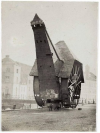The Treadwheel Crane

History of the Treadwheel Crane
The treadwheel crane, also known as a walking wheel crane, is one of the most iconic lifting devices from ancient and medieval times. It operated using human power, where a person would walk inside a giant wheel (similar to a hamster wheel) to generate rotational force, lifting heavy loads via a system of pulleys and ropes.
Origins:
The origin of the treadwheel crane dates back to Ancient Roman times (around the 1st century AD), where it was used in the construction of large structures like temples and aqueducts.
Its widespread use re-emerged in medieval Europe, especially between the 12th and 19th centuries.
Golden Age of Use:
These cranes were commonly used in harbors, church construction sites, and castles.
In major ports like Gdańsk (Poland), Strasbourg (France), and Bruges (Belgium), the treadwheel crane played a key role in loading and unloading ships.
Some cranes were even built permanently atop stone towers or large wooden structures.
How It Worked:
One or two people would walk inside the wheel, much like climbing stairs.
Their movement turned a drum that wound up a rope to lift heavy cargo.
Depending on the wheel’s size and human effort, the crane could lift tons of weight.
End of Its Era:
With the rise of steam engines in the 19th century, treadwheel cranes became obsolete, replaced by more efficient and powerful machinery.
However, several of these historic cranes still survive today as monuments and engineering heritage sites.










































































































































